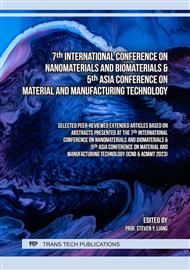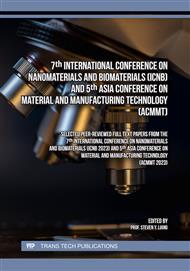[1]
S. Ahmed, Annu, A. Ali, J. Sheikh, A review on chitosan centred scaffolds and their applications in tissue engineering, Int. J. Biol. Macromol. 116 (2018) 849–862.
DOI: 10.1016/j.ijbiomac.2018.04.176
Google Scholar
[2]
S. Alven, S. Peter, Z. Mbese, B.A. Aderibigbe, Polymer-Based Wound Dressing Materials Loaded with Bioactive Agents: Potential Materials for the Treatment of Diabetic Wounds, Polymers (Basel). 14 (2022).
DOI: 10.3390/POLYM14040724
Google Scholar
[3]
R.S. Ambekar, B. Kandasubramanian, Advancements in nanofibers for wound dressing: A review, Eur. Polym. J. 117 (2019) 304–336.
DOI: 10.1016/j.eurpolymj.2019.05.020
Google Scholar
[4]
J. Jagur-grodzinski, Polymers for tissue engineering, medical devices, and regenerative medicine. Concise general review of recent studies, Polym. Adv. Technol. 17 (2006) 395–418.
DOI: 10.1002/pat.729
Google Scholar
[5]
M. Wu, P. Wu, L. Xiao, Y. Zhao, F. Yan, X. Liu, Y. Xie, C. Zhang, Y. Chen, L. Cai, Biomimetic mineralization of novel hydroxyethyl cellulose/soy protein isolate scaffolds promote bone regeneration in vitro and in vivo, Int. J. Biol. Macromol. 162 (2020) 1627–1641.
DOI: 10.1016/j.ijbiomac.2020.08.029
Google Scholar
[6]
F.H. Zulkifli, N.A.M. Rani, F. Shahitha, Carboxymethyl cellulose nanofibres impregnated with silver nanoparticles for tissue engineering applications, in: Mater. Today Proc., 2019.
DOI: 10.1016/j.matpr.2019.06.041
Google Scholar
[7]
H. Kargarzadeh, M. Mariano, J. Huang, N. Lin, I. Ahmad, A. Dufresne, S. Thomas, Recent developments on nanocellulose reinforced polymer nanocomposites: A review, Polymer (Guildf). (2017).
DOI: 10.1016/j.polymer.2017.09.043
Google Scholar
[8]
F.H. Zulkifli, F.S. Jahir Hussain, M.S.B. Abdull Rasad, M. Mohd Yusoff, Improved cellular response of chemically crosslinked collagen incorporated hydroxyethyl cellulose/poly(vinyl) alcohol nanofibers scaffold, J. Biomater. Appl. 29 (2015).
DOI: 10.1177/0885328214549818
Google Scholar
[9]
N. Grishkewich, N. Mohammed, J. Tang, K.C. Tam, Recent advances in the application of cellulose nanocrystals, Curr. Opin. Colloid Interface Sci. 29 (2017) 32–45.
DOI: 10.1016/J.COCIS.2017.01.005
Google Scholar
[10]
L.M. Hemmingsen, N. Škalko-Basnet, M.W. Jøraholmen, The expanded role of chitosan in localized antimicrobial therapy, Mar. Drugs. 19 (2021).
DOI: 10.3390/MD19120697
Google Scholar
[11]
T. Khaliq, M. Sohail, M.U. Minhas, S. Ahmed Shah, N. Jabeen, S. Khan, Z. Hussain, A. Mahmood, M. Kousar, H. Rashid, Self-crosslinked chitosan/κ-carrageenan-based biomimetic membranes to combat diabetic burn wound infections, Int. J. Biol. Macromol. 197 (2022) 157–168.
DOI: 10.1016/j.ijbiomac.2021.12.100
Google Scholar
[12]
Z. Shahbazarab, A. Teimouri, A. Najafi, International Journal of Biological Macromolecules Fabrication and characterization of nanobiocomposite scaffold of zein / chitosan / nanohydroxyapatite prepared by freeze-drying method for bone tissue engineering, Int. J. Biol. Macromol. 108 (2018) 1017–1027.
DOI: 10.1016/j.ijbiomac.2017.11.017
Google Scholar
[13]
X. Wang, L. He, B. Wei, G. Yan, J. Wang, R. Tang, Bromelain-immobilized and lactobionic acid-modified chitosan nanoparticles for enhanced drug penetration in tumor tissues, Int. J. Biol. Macromol. 115 (2018) 129–142.
DOI: 10.1016/j.ijbiomac.2018.04.076
Google Scholar
[14]
X. Zhao, R. Tian, J. Zhou, Y. Liu, Multifunctional chitosan/grape seed extract/silver nanoparticle composite for food packaging application, Int. J. Biol. Macromol. 207 (2022) 152–160.
DOI: 10.1016/J.IJBIOMAC.2022.02.180
Google Scholar



